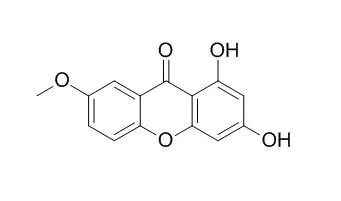| In vitro: |
| Planta Medica,1980,39(1):19-23. | | Inhibition of Type A and Type B Monoamine Oxidase by Isogentisin and its 3-O-Glucoside.[Reference: WebLink] |
METHODS AND RESULTS:
Isogentisin and its 3-O-glucoside were found to inhibit monoamine oxidase (MAO) in rat brain mitochondria in vitro using 5-hydroxytryptamine (5-HT) and (3-phenylethylamine (PEA) as relatively specific substrates for type A and type B MAO, respectively. Isogentisin showed much more potent MAO inhibition than its 3-O-glucoside for both substrates. The inhibition by both compounds was fully competitive for both substrates. Both compounds were found to be almost nonselective inhibitors for type A and type B MAO. popular medicine both in Europe and Asia due to their unique actions on the central nervous system [2]. In our previous preliminary communication [3], we briefly reported that Isogentisin and its 3-O-glucoside inhibit monoamine oxidase (MAO) in vitro using kynuramine as substrate.
CONCLUSIONS:
Since mitochondrial MAO is believed to exist in many animal tissues in two functional forms called type A and type B [4-6], in the present paper we have studied MAO inhibition by Isogentisin and its 3-O-glucoside using 5-hydroxytryptamine (5-HT) and (3-phenylethylamine (PEA) as relatively specific substrates for type A and type B MAO, respectively. | | Planta Medica, 2007, 73(9):871-871. | | Antimicrobial activity of Gentiana lutea L. extracts and isolated compounds mangiferin, isogentisin and gentiopicrin[Reference: WebLink] | Plant material of Gentiana lutea L. was collected on the mountain Suvobor. Air-dried leaves and flowers were extracted with methanol in a Soxhlet apparatus for 24h. Evaporated dry extracts were used for experiments.
METHODS AND RESULTS:
Mangiferin (MG), Isogentisin (IG) and gentiopicrin (GP) have been isolated according to previously published procedures [1] and their structures were confirmed using UV-VIS, IR and NMR techniques. A variety of microorganisms Escherichia coli (ATCC 25922), Salmonella typhimurium (ATCC 14028), Enterobacter cloacae (ATCC 13883), Pseudomonas aeruginosa (ATCC 27853), P. tolaasii (NCTC 387), Proteus mirabilis (ATCC 14273), Staphylococcus aureus (ATCC 25923), S. epidermidis (ATCC 12228), Streptococcus faecalis (ATCC 12952), Bacillus subtilis (ATCC 6051), Micrococcus luteus (ATCC 10240), M. flavus (ATCC 14452), Sarcina lutea (ATCC 10054), Listeria monocytogenes (ATCC 15313) as well as human pathogen fungi Candida albicans were used in the antimicrobial assay. The MIC values have been determined using the broth microdilution method in 96-hole plates according to NCCLS [2]. Serial dilutions of the stock solutions of tested extracts in broth medium (Muller-Hinton broth or Sabouraud broth) were prepared in a microtiter plate. The microbial suspensions were added in the microwells at the concentration of 5×105 organisms/mL. MICs were determined as the lowest concentrations preventing visible growth. The standard antibiotic streptomycin was used to control the sensitivity of tested bacteria, whereas nystatin was used as a control against the fungi. Each assay was repeated two times. Leaves contained 9.57±0.4mg/g dw of MG, 12.86±0.7mg/g dw of IG and 38.85±0.7mg/g dw of GP while flowers contained 8.98±0.4mg/g dw of MG, 123.23±3.1mg/g dw of IG and 48.38±1.4mg/g dw of GP.
CONCLUSIONS:
Mangiferin, Isogentisin and gentiopicrin as well as extracts of leaves and flowers showed antimicrobial activity with MIC values ranging from 117–310µg/ml. |
|






 Cell. 2018 Jan 11;172(1-2):249-261.e12. doi: 10.1016/j.cell.2017.12.019.IF=36.216(2019)
Cell. 2018 Jan 11;172(1-2):249-261.e12. doi: 10.1016/j.cell.2017.12.019.IF=36.216(2019) Cell Metab. 2020 Mar 3;31(3):534-548.e5. doi: 10.1016/j.cmet.2020.01.002.IF=22.415(2019)
Cell Metab. 2020 Mar 3;31(3):534-548.e5. doi: 10.1016/j.cmet.2020.01.002.IF=22.415(2019) Mol Cell. 2017 Nov 16;68(4):673-685.e6. doi: 10.1016/j.molcel.2017.10.022.IF=14.548(2019)
Mol Cell. 2017 Nov 16;68(4):673-685.e6. doi: 10.1016/j.molcel.2017.10.022.IF=14.548(2019)